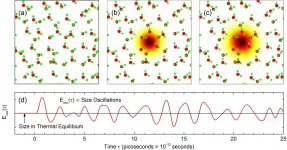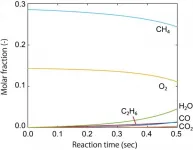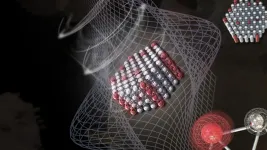Nanoprinted high-neuron density optical linear perceptrons performing near-infrared inference on a C
Optical inference by AI holographic nanostructures
2021-03-04
(Press-News.org) Intelligent holographic nanostructures on CMOS sensors for energy-efficient AI security schemes
Today, machine learning permeates our everyday life, with millions of users every day unlocking their phones through facial recognition or passing through AI-enabled automated security checks at airports and train stations. These tasks are possible thanks to sensors that collect optical information to feed it to a neural network in a computer. Imagine to empower the sensors in the devices you use every day to perform artificial intelligence functions without a computer - as simply as putting glasses on them.
The integrated holographic perceptrons developed by a research team at University of Shanghai for Science and Technology led by Professor Min Gu, a foreign member of the Chinese Academy of Engineering, can make that a reality. They realized an AI optical circuit, with a neural density equal to 1/400 of human brain.The circuit is trained to process information through unpowered all-optical inference at the speed of light with a computational power more than ten orders of magnitude larger than electronic processors. In future, its neural density is expected to be 10 times that of human brain.
How it works
Traditionally, visual information is translated into electronic information, which is then processed by energy-hungry hardware. The technology Professor Gu's team developed allows to skip this translation step, and process the optical information directly and without using any power.
Elena Goi, the first author of the published paper and a key member of Prof Gu's team, said that the processing of optical information is enabled by state-of-the-art nanofabrication.
"By employing high-precision 3D nanofabrication technology, we are able to add AI optical elements to industry-standard imaging sensors. This is comparable to putting tailored, task-specific smart glasses on the imaging sensors, which process the incoming optical information before it is even detected."
Impact
Using a state-of-the-art laser 3D-nanoprinting technology, the researchers fabricate optical perceptrons with a neuron density of over 500 million neurons per square centimetre. The nanoscale feature size of these smart optical elements pushes the upper limit for the computational power for the nanoprinted decryptors lies at 400 ExaFLOPS (1018 FLOPS, floating operations per second), an increase in the operations per second of five orders of magnitude compared with integrated photonic hardware.
By printing the perceptrons directly on CMOS imaging chips, Goi said, it is possible to realise AI optical circuits, which not only outperform current optical methods, but show the potential for application in a wide range of fields from security check, medical diagnostics, automatic driving, satellite image processing, etc.
According to Professor Gu, this technology will enable a whole new family of energy-efficient AI-enabled edge devices for processing optical information. This is of particular importance for applications where energy consumption is critical or data connectivity is limited, for example smart sensing devices in remote areas or smart sensors for long term deployment.
INFORMATION:
This research was published on Light: Science and applications with the title of "Nanoprinted high-neuron-density optical linear perceptrons performing near-infrared inference on a CMOS chip." on March, 3.
ELSE PRESS RELEASES FROM THIS DATE:
2021-03-04
Nairobi/Paris, 4 March 2021 - An estimated 931 million tonnes of food, or 17% of total food available to consumers in 2019, went into the waste bins of households, retailers, restaurants and other food services, according to new UN research conducted to support global efforts to halve food waste by 2030.
The weight roughly equals that of 23 million fully-loaded 40-tonne trucks -- enough bumper-to-bumper to circle the Earth 7 times.
The Food Waste Index Report 2021, from the United Nations Environment Programme (UNEP) and partner organization WRAP, looks at food waste that occurs in retail outlets, restaurants and homes - ...
2021-03-04
People with higher incomes tend to feel prouder, more confident and less afraid than people with lower incomes, but not necessarily more compassionate or loving, according to research published by the American Psychological Association.
In a study of data from 162 countries, researchers found consistent evidence that higher income predicts whether people feel more positive "self-regard emotions," including confidence, pride and determination. Lower income had the opposite effect, and predicted negative self-regard emotions, such as sadness, fear and shame. The research was published online in the journal Emotion. ...
2021-03-04
A group of researchers, spanning six universities and three continents, are sounding the alarm on a topic not often discussed in the context of conservation--misinformation.
In a recent study published in FACETS, the team, including Dr. Adam Ford, Canada Research Chair in Wildlife Restoration Ecology, and Dr. Clayton Lamb, Liber Ero Fellow, both based in the Irving K. Barber Faculty of Science, explain how the actions of some scientists, advocacy groups and the public are eroding efforts to conserve biodiversity.
"Outcomes, not intentions, should be the basis for how we view success in conservation," says Dr. Ford.
"Misinformation related to vaccines, climate change, and links between smoking ...
2021-03-04
Ionization of water molecules by light generates free electrons in liquid water. After generation, the so-called solvated electron is formed, a localized electron surrounded by a shell of water molecules. In the ultrafast localization process, the electron and its water shell display strong oscillations, giving rise to terahertz emission for tens of picoseconds.
Ionization of atoms and molecules by light is a basic physical process generating a negatively charged free electron and a positively charged parent ion. If one ionizes liquid water, the free electron undergoes a sequence of ultrafast processes by which it loses energy and eventually localizes at a new site in ...
2021-03-04
CHAPEL HILL, North Carolina--UNC Lineberger Comprehensive Cancer Center researchers have successfully used an experimental safety switch, incorporated as part of a chimeric antigen receptor T-cell (CAR-T) therapy, a type of immunotherapy, to reduce the severity of treatment side effects that sometimes occur. This advance was seen in a patient enrolled in a clinical trial using CAR-T to treat refractory acute B-cell leukemia. It demonstrates a proof-of-principle for possible expanded use of CAR-T immunotherapy paired with the safety switch.
The researchers published their findings in the journal Blood as an ahead-of-print publication.
With CAR-T therapy, T-cells from a patient's immune system ...
2021-03-04
The human genome contains roughly three million letters. On average, the genome sequences of any two people differ from each other by about one in every 1,000 letters. Yet different variants occur, from substituted letters to entire missing sections of DNA. Scientists from the Berlin Institute of Health (BIH) and the Regensburg Center for Interventional Immunology (RCI) have teamed up with Icelandic researchers to develop software that reliably and quickly identifies large deletions in ten-thousands of genomes simultaneously. The researchers have now published their findings in the journal Nature Communications.
The human genome contains roughly three million letters ...
2021-03-04
Japanese researchers have developed a simulation method to theoretically estimate the performance of heterogeneous catalyst by combining first-principles calculation (1) and kinetic calculation techniques. Up to now, simulation studies mainly focused on a single or limited number of reaction pathways, and it was difficult to estimate the efficiency of a catalytic reaction without experimental information.
Atsushi Ishikawa, Senior Researcher, Center for Green Research on Energy and Environmental Materials, National Institute for Materials Science (NIMS), performed computation of reaction kinetic information from first-principles calculations based on quantum mechanics, and developed methods and programs to carry out kinetic simulations ...
2021-03-04
The speed at which we produce facial expressions plays an important role in our ability to recognise emotions in others, according to new research at the University of Birmingham.
A team in the University's School of Psychology carried out research which showed that people tend to produce happy and angry expressions more rapidly, while sad expressions are produced more slowly.
The team found that our ability to form judgements about people's facial expressions has close links with the speeds at which those expressions are produced and is also closely related to the ways in which we would produce those expressions ourselves. The study is published in Emotion.
"Being able to recognise and interpret ...
2021-03-04
Much like the Jedis in Star Wars use 'the force' to control objects from a distance, scientists can use light or 'optical force' to move very small particles.
The inventors of this ground-breaking laser technology, known as 'optical tweezers', were awarded the 2018 Nobel Prize in physics.
Optical tweezers are used in biology, medicine and materials science to assemble and manipulate nanoparticles such as gold atoms. However, the technology relies on a difference in the refractive properties of the trapped particle and the surrounding environment.
Now scientists have discovered a new technique that allows them to manipulate particles that have the same refractive ...
2021-03-04
The vegan diet is on trend. How this type of diet affects health is the subject of scientific studies. In a new study from the German Federal Institute for Risk Assessment (BfR), the bone health of 36 vegans as well as 36 people following a mixed-food diet was determined with an ultrasound measurement of the heel bone. The result: on average, people following a vegan diet had lower ultrasound values compared to the other group. This indicates poorer bone health.
In the study, the scientists also determined biomarkers in blood and urine. This aims ...
LAST 30 PRESS RELEASES:
[Press-News.org] Nanoprinted high-neuron density optical linear perceptrons performing near-infrared inference on a C
Optical inference by AI holographic nanostructures




